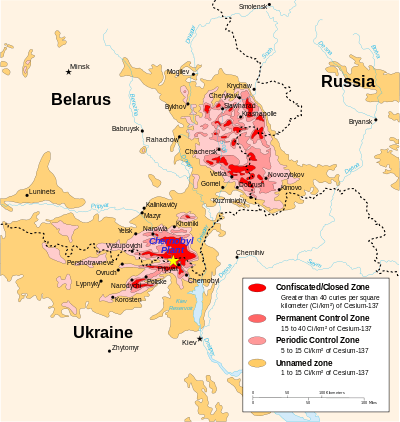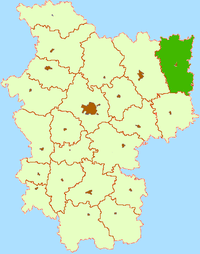Krupki
| Krupki [1] Крупкі | |||
|---|---|---|---|
| |||
| Nickname(s): Krupka | |||
 Krupki district, Miensk province. | |||
| Coordinates: 54°19′N 29°08′E / 54.317°N 29.133°ECoordinates: 54°19′N 29°08′E / 54.317°N 29.133°E[1] | |||
| Country Subdivision | Minsk Voblast | ||
| Government | |||
| • Chairman of the Krupki Region Executive Committee | Igor Chesnok[2] | ||
| Area | |||
| • Total | 276.51 km2 (106.76 sq mi) | ||
| • Land | 276.51 km2 (106.76 sq mi) | ||
| • Water | 0.01 km2 (0.004 sq mi) | ||
| Elevation | 174 m (571 ft) | ||
| Population (2012) | |||
| • Total | 7,900[3] | ||
| Time zone | FET (UTC+3) | ||
| Area code(s) | +375 1796 | ||
Krupki (Belarusian: Крупкі, Polish: Krupki, Russian: Крупки) is a small, rural town in Krupki Raion, near Mogilev city in Belarus.[4]
History
History before 1914
Krupki was founded in 1067 and existed during both the medieval Kingdom of Poland and of the great Polish–Lithuanian Commonwealth. Krupki was then absorbed into the Grand Duchy of Lithuania, after which, the district was annexed by the Russian Empire in 1793. Krupki became the administrative centre of its district and got its own council in 1900. The town’s coat of arms is a white, blue and yellow shield.[5] The old, wooden Bogoroditskaya Church in the nearby village of Hodovcy is of tourist and historic value.[6]

The town's population was 1,800 (mostly Jewish) people in 166 houses, according to an 1895 Russian Encyclopedia,[1] and 2,080 (largely non 'Hebrews') in 1926 as according to a similar reference book of 1961.[1] There is no apparent evidence that any of Russia's endemic famines or pre-Revolutionary bread riots had broken out in Krupki town or its immediate environs.
Jewish community
The Yiddish Jewish settlement in Krupki is first noted in the 17th century and was thriving by the middle of the 18th century. About 40% of the Jews were employed as labours and craftsmen[7] and a Yiddish school was established in the town.[7] There were three Hebrew schools in Krupki by the 1890s according to the 1895 Russian Encyclopedia.[1]
About 75% of the local Jews fled the town during the Russian Revolution and subsequent Russian Civil War,[7] for either Western Europe or United States. Only 870 of them remained in situ by 1939.[7][8] There were also small Polish, Poleszuk(“Tutejsi”), Lithuanian and Roma settlements in Krupki.
World War I and World War II
The town was briefly taken by a small unit of Prussian troops during the later part of the war. Belarus first declared independence on 25 March 1918, forming the Belarusian People's Republic and later the Communist Party (bolsheviks) of Lithuania and Belorussia took it over in Belarus. As a result of this turn of fate, Krupki was incorporated in the U.S.S.R. after the western parts of Belarus and the border city of Brest were given to Poland and the eastern parts, along with the city of Minsk, joined the U.S.S.R., between the two world wars.
Nazi Germany invaded the Soviet Union in 1941.
On September 18, 1941 the entire Jewish Ghetto,[7] a community of 1,000 people were killed by the Nazis.[9][10][11][12] The massacre was described in the diary of one of the German perpetrators.[12] The first massacre involved 100 deaths near the grave yard,[7] but a later killing spree killed roughly 900 other Jews in different location.
At first, the Germans told the Jews to gather together because that were being deported to Germany.[12] But as the German forced them into a ditch, it was evident what the Germans had in mind. At this point, panic ensued.[12]
Ten shots rang out, ten Jews popped off. This continued until all were dispatched. Only a few of them kept their countenances. The children clung to their mothers, wives to their husbands. I won’t forget this spectacle in a hurry...[12]
Some of the Germans and Austrians involved in the incident were also injured during the panic. Very few, if any, of the local Belarusians, Roma/Gypsies or Poles supported the anti-Semitic attack and a few even actively opposed Nazi rule in their town altogether. Krupki was liberated by the Red Army in June 1944.[7][13] Belarus was the hardest hit Soviet Republic in the war and remained in Nazi hands until it was liberated during the Minsk Offensive of 1944. The Jewish population of Belarus was devastated during The Holocaust [14] and never recovered.[15]
During the Cold War
The town was violently purged by the KGB.[16] It was to stay as part of the Belorussian SSR until 1991, when it became part of the state of Belarus.[13] Krupki's population had reached 5,000 by 1977.
The Junior Sergeant, Rifleman Kriptoshenko Vladimir Olegovich was awarded the Order of the Red Banner and Order of the Red Star (both posthumously) after being killed by grenade explosion during the 1988 Battle for Hill 3234 whilst serving in the Soviet occupation of Afghanistan.[17]

The Oblast was moderately irradiated in the Chernobyl disaster.[18]
The post-Soviet era
Krupki became a part of the state of Belarus in 1991 after the collapse of the Soviet Union. A memorial cross dedicated to the victims of the Soviet purge was destroyed by Neo-Communists in 2009.[16] There are various memorials, dedicated to the Soviet heroes Alena Kolesova, U.M. Martinkevich and astronaut Vladimir Kovalyonok.[6]
Geography
Krupki lie 65 mi (110 km) to the East from Minsk[1] and set at a height of 174 m.[6][13][19] The name means either to grind grain or the (grain) mill.[1]

Bobr river flows through the town. Climate of Krupki is moderately continental, a transitional form from maritime to continental climate with relatively mild winters and warm summers.
Demographics
It is mostly inhabited by Belarusians, but has Russian, Polish, Ukrainian and Jewish[20] minorities. The population was around 5,000 in 1977.[6]
Krupki has Eastern Orthodox, Catholic, Protestant and Jewish communities. There is a synagogue and several churchs in the town[20] and the nearby wooden orthodox church.
Economy and transportation
It consists of both woodworking, flax, forestry, the farming of fruit and vegetables and food processing.[6] It once used to make pottery, produce bread and manufacture matches.[1]
The roads are mostly tarmacked and are of an average grade for Belarusian road ways. The nearest airports are in Minsk and Krupki has a railway station.
References
- ↑ 1.0 1.1 1.2 1.3 1.4 1.5 1.6 1.7 "Shtetls of Belarus: Krupki, Senno uyezd, Mogilev gubernia". Retrieved 29 January 2010.
- ↑ "Home - Krupki Region Executive Committee". Retrieved 4 October 2014.
- ↑ "Population of Krupki, Belarus". mongabay.
- ↑ "Google satellite map of Krupki.". Retrieved 29 January 2010.
- ↑ "Coat of arms of Krupki". Toman. Archived from the original on 26 February 2012.
- ↑ 6.0 6.1 6.2 6.3 6.4 "Krupki: maps, photo, heraldry, history, sites". Cities of Belarus.
- ↑ 7.0 7.1 7.2 7.3 7.4 7.5 7.6 "Krupki". Yad Vashem The Holocaust Martyrs' and Heroes' Remembrance Authority. Archived from the original on 24 April 2009.
- ↑ "Soviet Reports". Yad Vashem The Holocaust Martyrs' and Heroes' Remembrance Authority. Archived from the original on 24 April 2009.
- ↑ Krupki Massacre
- ↑ Genealogical records for Krupki District, 1932 - 1933
- ↑ Eyewitness Describes Nazi Massacre in Krupki
- ↑ 12.0 12.1 12.2 12.3 12.4 Bronner, Ethan (19 April 2009). "Research on Smaller Nazi Sites Is Now Public". The New York Times. Retrieved 20 April 2009.
- ↑ 13.0 13.1 13.2 Belarusian Waltz
- ↑ Holocaust in Belorussia, 1941-1944
- ↑ Fedor, Helen (1995). "Belarus - Stalin and Russification". Belarus: A Country Study. Library of Congress. Retrieved 26 March 2006.
- ↑ 16.0 16.1 Krupki: destruction of memorial cross to Communism victims
- ↑ Battle for Hill 3234
- ↑ "Krupki, Belarus News". Topix.
- ↑ "Krupki". Tageo.com.
- ↑ 20.0 20.1 Krupki town at Radzima.org
External links
| |||||||||||||||||

